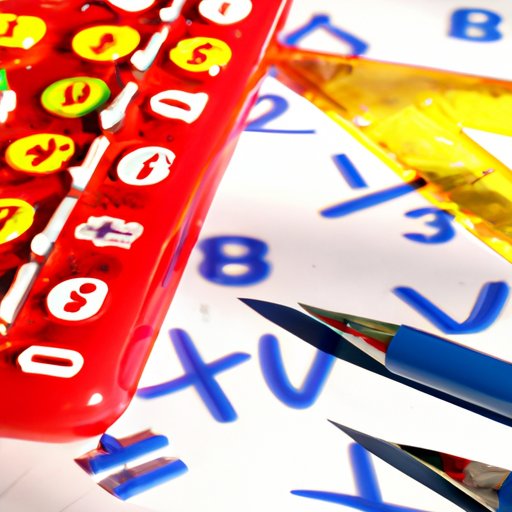
Introduction
Mathematics is one of the most fundamental and important subjects we learn from an early age. It is not only a core subject in school curriculums but also plays an integral role in daily life. Whether calculating bills, managing budgets, or analyzing data, we use math regularly without even realizing it. This article explores the basic fundamentals of math, progression of concepts, resources and tools, visual aids and mnemonic techniques, breaking down complex math formulas, real-world applications of math, and mistakes to avoid while solving math problems.
Basic Fundamentals of Math
Mathematics deals with the study of numbers, their properties, and their relationships with each other. The basic concepts of math include numbers, arithmetic operations, and algebra. Numbers can be whole, fractional, negative, or positive and can be added, subtracted, multiplied or divided. Algebra deals with equations and formulas, and understanding it is important for higher math concepts. To improve math skills, it is essential to practice regularly and identify areas where you may be weak. Here are some practice exercises:
- Calculate the sum of 678 and 345
- Convert 2/5 into a decimal number
- Solve for X: 3X + 2 = 14
Progression of Math
The progression of math involves building on the basics to understand more complex concepts such as geometry, trigonometry, and calculus. Geometry is the study of shapes and their properties, trigonometry deals with triangles and their relationships, and calculus is the study of functions, limits, and derivatives. Understanding each concept is crucial to solve more complex math problems. Here are examples of each math concept:
Geometry
Geometry deals with the relationship between shapes and their properties. For instance, the length of the perimeter of a square can be calculated by multiplying the length of one side by four.
- Calculate the perimeter of a square if the length of one side is 10cm
- Calculate the area of a triangle with base 5cm and height 10cm
Trigonometry
Trigonometry provides a means of understanding the relationship between sides and angles in a triangle. For instance, the sine function is commonly used to calculate angle measures for triangles.
- Find the angle measurement for a triangle with sides of 5cm, 8cm, and 10cm
- Calculate the length of a side of a triangle with angle 60 degrees and side length of 10cm
Calculus
Calculus deals with the study of functions, limits, and derivatives. For instance, the derivative of a function is used to find the slope of a curve at any given point.
- Find the derivative of f(x) = 2x + 5
- Find the limit of g(x) = (x^2 – 4x + 6) / (x – 2) as x approaches 2
Resources and Tools
Learning math can be made easier by taking advantage of various resources and tools available online. Websites such as Khan Academy, Mathway, and Wolfram Alpha provide step-by-step solutions to math problems. Additionally, there are mobile applications such as Photomath and Desmos that students can use to solve math problems and create graphs. Some of the resources may have a limited free trial, so it is essential to weigh the features, benefits, and limitations to know which tool suits your needs best.
Visual Aids and Mnemonic Techniques
Visual aids such as diagrams, graphs, and infographics are useful in helping students understand math concepts. Memory tricks can also come in handy when it comes to memorizing formulas and concepts. For instance, you can use acronyms like PEMDAS, meaning Parentheses, Exponents, Multiplication, Division, Addition, and Subtraction, to remember the order of operations. Here are various mnemonic techniques:
- Making up a memorable phrase for memorizing formulas
- Using visual aids such as charts and diagrams to help you understand math concepts
- Repeating formulas out loud to help them stick in your memory
Breaking Down Complex Math Formulas
Breaking down complicated math formulas and equations can help students understand them better. First, identify the different components or parts of the problem. Then, use practical examples to help you understand how each component interacts with others to form the complete solution.
- Break down the formula for calculating compound interest and explain each part
- Break down the equation for finding the slope of a line, and explain each part
Real-world Applications of Math
Math concepts are essential in everyday life, and their relevance extends beyond academic and scientific pursuits. Areas where math is applied include budgeting, measuring, and data analysis. Without a firm understanding of math concepts, it is impossible to solve real-life problems. Here are examples of how math applies to different scenarios:
- Calculating your budget for grocery shopping
- Figuring out how much paint to buy to cover a room’s walls
- Interpreting data from a survey or poll
Mistakes in Math Problem Solving
Common mistakes that students make while solving math problems include calculation errors, not paying attention to details, or using the wrong formula. It is essential to develop a problem-solving strategy and double-check answers for accuracy. Here are some tips to avoid these mistakes:
- Read the instructions carefully
- Pay attention to details, such as the units of measurement and the order of operations
- Double-check answers to ensure that they are correct
Conclusion
In summary, math is a crucial subject with real-world applications. It is essential to understand the basic concepts, progression of math, utilize available resources and tools, use visual aids and mnemonic techniques, breakdown complex math formulas, apply math concepts in real-world scenarios, and avoid common math mistakes. Keep practicing and using the tips and techniques outlined above, and you will see a marked improvement in your math skills.





